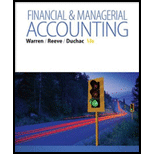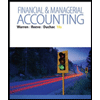
Financial & Managerial Accounting
13th Edition
ISBN: 9781285866307
Author: Carl Warren, James M. Reeve, Jonathan Duchac
Publisher: Cengage Learning
expand_more
expand_more
format_list_bulleted
Concept explainers
Question
Chapter 13, Problem 7EX
To determine
Stock investments:
Stock investments are equity securities which claim ownership in the investee company and pay dividend revenue to the investor company.
Journal entry is a set of economic events which can be measured in monetary terms. These are recorded chronologically and systematically.
Debit and credit rules:
- Debit an increase in asset account, increase in expense account, decrease in liability account, and decrease in
stockholders’ equity accounts. - Credit decrease in asset account, increase in revenue account, increase in liability account, and increase in stockholders’ equity accounts.
To journalize: The stock investment transactions in the books of Company C.
Expert Solution & Answer
Want to see the full answer?
Check out a sample textbook solution
Students have asked these similar questions
Please explain the solution to this general accounting problem using the correct accounting principles.
I need assistance with this financial accounting problem using appropriate calculation techniques.
Norstar Components Ltd. budgets the following for the year ended December 31, 2024: Total direct materials placed into production: $162,700 and Total direct labor cost: $243,600. Assume the estimated inventories on January 1, 2024, for finished goods and work in process were $14,800 and $6,300, respectively. Also, assume the desired inventories on December 31, 2024, for finished goods and work in process were $10,200 and $5,900, respectively. Factory overhead was budgeted at $135,000. How much is the budgeted cost of goods sold (COGS) for 2024?
Chapter 13 Solutions
Financial & Managerial Accounting
Ch. 13 - Prob. 1DQCh. 13 - What causes a gain or loss on the sale of a bond...Ch. 13 - Prob. 3DQCh. 13 - Prob. 4DQCh. 13 - Prob. 5DQCh. 13 - Prob. 6DQCh. 13 - Prob. 7DQCh. 13 - Prob. 8DQCh. 13 - What are the factors contributing to the trend...Ch. 13 - Prob. 10DQ
Ch. 13 - Prob. 1APECh. 13 - Bond investment transactions Journalize the...Ch. 13 - Prob. 2APECh. 13 - Stock investment transactions On September 12,...Ch. 13 - Prob. 3APECh. 13 - Prob. 3BPECh. 13 - Prob. 4APECh. 13 - Prob. 4BPECh. 13 - Prob. 5APECh. 13 - Prob. 5BPECh. 13 - Prob. 6APECh. 13 - Prob. 6BPECh. 13 - Prob. 1EXCh. 13 - Prob. 2EXCh. 13 - Prob. 3EXCh. 13 - Prob. 4EXCh. 13 - Prob. 5EXCh. 13 - Entries for investment in stock, receipt of...Ch. 13 - Prob. 7EXCh. 13 - Prob. 8EXCh. 13 - Entries for stock investments, dividends, and sale...Ch. 13 - Prob. 10EXCh. 13 - Prob. 11EXCh. 13 - Prob. 12EXCh. 13 - Prob. 13EXCh. 13 - Prob. 14EXCh. 13 - Prob. 15EXCh. 13 - Prob. 16EXCh. 13 - Fair value journal entries, trading investments...Ch. 13 - Prob. 18EXCh. 13 - Prob. 19EXCh. 13 - Prob. 20EXCh. 13 - Prob. 21EXCh. 13 - Prob. 22EXCh. 13 - Prob. 23EXCh. 13 - Prob. 24EXCh. 13 - Prob. 25EXCh. 13 - Prob. 26EXCh. 13 - Prob. 27EXCh. 13 - Prob. 28EXCh. 13 - Prob. 29EXCh. 13 - Debt investment transactions, available-for-sale...Ch. 13 - Prob. 2APRCh. 13 - Stock investment transactions, equity method and...Ch. 13 - Prob. 4APRCh. 13 - Prob. 1BPRCh. 13 - Prob. 2BPRCh. 13 - Stock investment transactions, equity method and...Ch. 13 - Prob. 4BPRCh. 13 - Selected transactions completed by Equinox...Ch. 13 - Benefits of fair value On July 16, 1998, Wyatt...Ch. 13 - Prob. 2CPCh. 13 - Prob. 3CPCh. 13 - Prob. 4CP
Knowledge Booster
Learn more about
Need a deep-dive on the concept behind this application? Look no further. Learn more about this topic, accounting and related others by exploring similar questions and additional content below.Similar questions
- Fairmont Inc. purchased merchandise inventory for $85,000 on account with terms 2/10, n/30. If the company pays the invoice within the discount period, what is the amount of the payment?arrow_forwardI am looking for help with this general accounting question using proper accounting standards.arrow_forwardSub. General Account. Dont accept ill give you unhelpfularrow_forward
- Can you help me solve this general accounting question using valid accounting techniques?arrow_forwardDavid Manufacturing has budgeted sales for March, April, and May of 15,500, 19,800, and 17,300 units, respectively. Each unit that David Manufacturing produces uses 4.2 pounds of raw material. The company requires 25% of the next month's budgeted production as raw material inventory each month. David Manufacturing currently pays a standard rate of $1.75 per pound for raw materials. Each unit should be produced in 15 minutes of direct labor time at a standard direct labor rate of $14.50 per hour. Manufacturing overhead is applied at a standard rate of $18.50 per direct labor hour. Calculate the standard cost per unit for David Manufacturing. (Round your answer to 2 decimal places.)arrow_forwardCan you help me solve this financial accounting question using the correct financial procedures?arrow_forward
arrow_back_ios
SEE MORE QUESTIONS
arrow_forward_ios
Recommended textbooks for you
 Financial AccountingAccountingISBN:9781305088436Author:Carl Warren, Jim Reeve, Jonathan DuchacPublisher:Cengage Learning
Financial AccountingAccountingISBN:9781305088436Author:Carl Warren, Jim Reeve, Jonathan DuchacPublisher:Cengage Learning Financial & Managerial AccountingAccountingISBN:9781285866307Author:Carl Warren, James M. Reeve, Jonathan DuchacPublisher:Cengage Learning
Financial & Managerial AccountingAccountingISBN:9781285866307Author:Carl Warren, James M. Reeve, Jonathan DuchacPublisher:Cengage Learning Financial Accounting: The Impact on Decision Make...AccountingISBN:9781305654174Author:Gary A. Porter, Curtis L. NortonPublisher:Cengage Learning
Financial Accounting: The Impact on Decision Make...AccountingISBN:9781305654174Author:Gary A. Porter, Curtis L. NortonPublisher:Cengage Learning

Financial Accounting
Accounting
ISBN:9781305088436
Author:Carl Warren, Jim Reeve, Jonathan Duchac
Publisher:Cengage Learning

Financial & Managerial Accounting
Accounting
ISBN:9781285866307
Author:Carl Warren, James M. Reeve, Jonathan Duchac
Publisher:Cengage Learning

Financial Accounting: The Impact on Decision Make...
Accounting
ISBN:9781305654174
Author:Gary A. Porter, Curtis L. Norton
Publisher:Cengage Learning